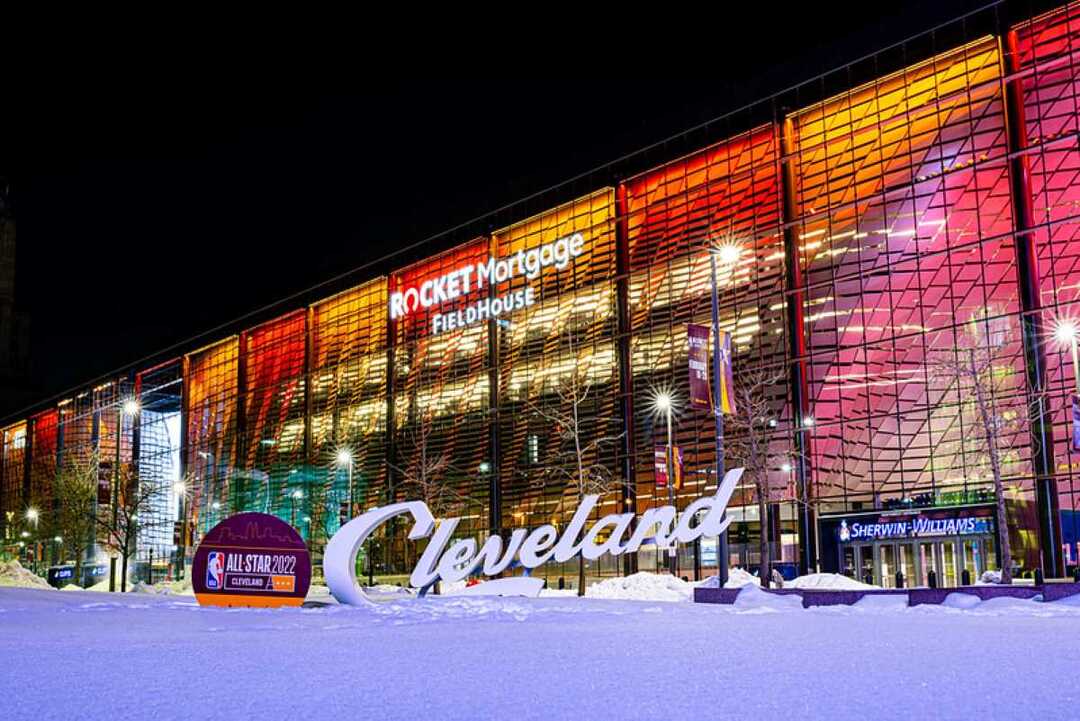
In the 1970s, Cleveland's outlook was grim. The city was losing large swaths of its population, defaulting on its loans, planning on converting Playhouse Square to a parking lot, and becoming known as "Bomb City USA" due to mob violence. The Cuyahoga River was dying, and manufacturing in the city was on the decline. The city's National Basketball Association franchise, the Cleveland Cavaliers, was established in 1970, at the beginning of this tumultuous decade. The first home of the Cavs was the historic Cleveland Arena on Euclid Avenue near E. 36th Street. The Arena was beloved by some for hosting Alan Freed's Moondog Coronation Ball in 1952, but was well past its prime and hardly suitable for a modern NBA team. After only four years, the Cavaliers, like many downtown Cleveland businesses, moved out of the city and into the suburbs.
Richfield, Ohio would be the new hometown of the Cavaliers and the Richfield Coliseum their arena. Although the Coliseum featured state-of-the-art architecture at the time of its opening, Richfield never developed the way that Cavaliers' owner Nick Mileti had hoped. Mileti imagined Richfield developing rapidly with new roads, businesses, and sports facilities to create "a megalopolis stretching from Cleveland to Akron." Due to the creation of the 50-square-mile Cuyahoga Valley National Recreation Area in 1974, this never materialized and Richfield remained an isolated and rural town, far from most of the team's fans and overwhelmed by out-of-town car traffic. The Richfield experiment had failed.
When Gordon Gund became the principal owner of the Cavaliers in 1983, the organization began searching for a new home in Cleveland, with hopes of sparking a downtown revitalization. To make an impact, Cleveland needed something more significant than just a sports arena with four walls and a roof. To accomplish this, the city used the concept of an urban entertainment district, or UED, in the creation of Gund Arena. In 1990, the Gateway Economic Development Corporation was formed to build a stadium for the Cavaliers and to create a financially productive district for Cleveland.
The Gateway project was unveiled amidst years of sports-related controversy. A plan for a domed sports complex had already failed to generate sufficient public and political support. In 1984, voters had rejected a $150 million bond issue to fund the domed stadium by a vote of nearly two to one. For the Gateway plan to succeed, the city and the team would need to generate support for the public funding portion of the project. In 1990, following endorsements from business and civic leaders, voters approved a "sin tax" on liquor and cigarettes by a narrow margin of 52 percent to 48 percent. With public funding secured, the path was cleared for the Gateway Project to begin and for the Cavaliers to build their new home downtown.
Gund Arena opened on October 17, 1994. After a decade of planning and work, the result was a state-of-the-art sports facility that was "well integrated into the existing fabric of downtown." At the grand opening of the venue, visitors got their first look at the curved roof, glass walls, and large arcades throughout the stadium. The interior of the complex was visible from the outside and featured, "lobbies, a restaurant and sports bar, box offices, stairways and escalators." The architects – from Ellerbe Becket and Robert P. Madison International – succeeded in making the stadium seem open and living in accordance with the rest of downtown Cleveland.
Team and public expectations for stadiums and arenas never remain unchanged. By the 2010s, Gund Arena, by then known as Quicken Loans Arena following its purchase by Dan Gilbert, was no longer state-of-the-art in comparison to some cities' newer venues. The impetus for renovation drew strength from the increasing importance of the venue. Quicken Loans Arena (or "the Q" as it was then known) hosted the 2016 Republican Convention and was also one of six finalists to host the 2016 Democratic National Convention. That same year, the Cavaliers won the NBA championship. In 2018-2019, the arena underwent a massive $185 million renovation in which the team and taxpayers shared the cost, with the Cavs contributing around 68% of the total after cost overruns. The changes included an increase in square footage, a new glass entryway to emphasize a connection to downtown Cleveland, new wireless access points, luxury suites, membership spaces, and an additional 731 television monitors. With renovations complete, and the arena newly-rechristened as Rocket Mortgage FieldHouse, the Cavaliers signed a lease to occupy the space until 2034. When that lease expires, the arena will have been home to the Cavaliers for 40 years following their move in 1994.
In 2022, Rocket Mortgage FieldHouse (or "the Rock," as it has come to be known) hosted the National Basketball Association's All-Star Weekend event. Thanks to continuous improvement and innovation, the complex was able to host these events in both 1997 and 2022, for the 50th and 75th anniversaries of the NBA. Despite controversy regarding the initial funding for the project as well as for ongoing maintenance, Rocket Mortgage FieldHouse has proven to be an unwavering symbol of Cleveland.
Images







